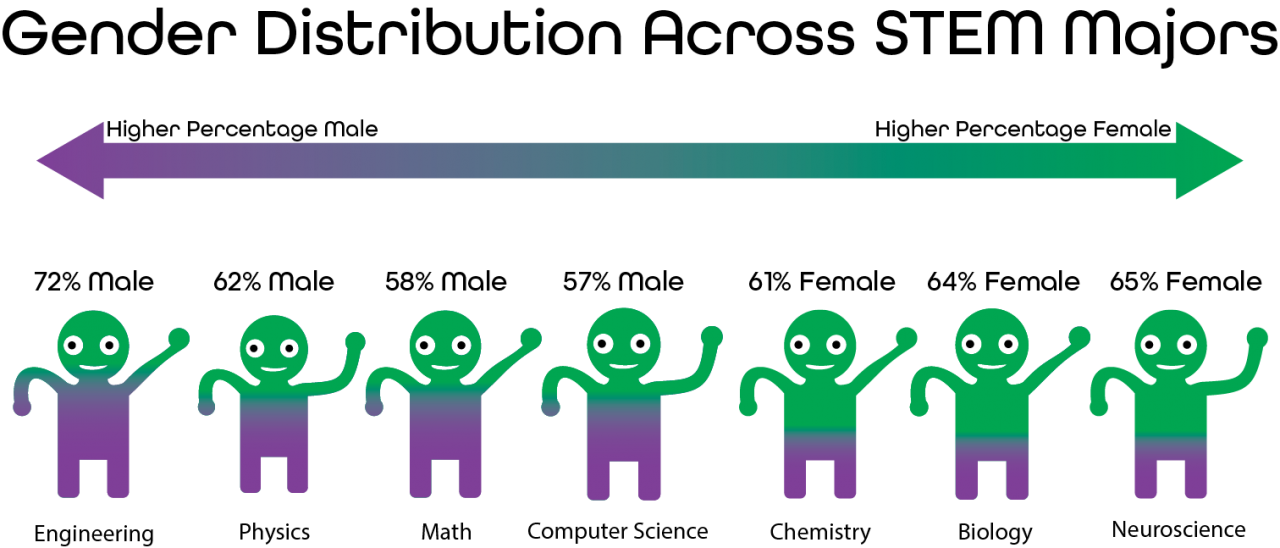Graphic by Quinn Butterfield
Of this semester’s 1,398 students enrolled in geoscience, biology, chemistry, neuroscience, computer science, math, physics and engineering classes, 50 percent are female, and 39 percent are racial or ethnic minorities.
The Departments of Biology, Chemistry and Neuroscience have similar gender make-ups. Biology is 64 percent female, chemistry is 61 percent female, and neuroscience is 65 percent female.
The minority make up of the departments all lean towards majority white. Biology is 43 percent minority students, chemistry is 47 percent minority students, and neuroscience is 39 percent minority students. For the Department of Geoscience, 53 percent of students are female and 31 percent are minorities.
On the biology side of things, Michele Johnson, associate professor of biology, believes the nature of STEM brings people from all walks of life to the field.
“Biology is the study of life! It’s a field that connects chemistry, physics and math to understand organisms in the natural world. There are so many important applications of biology, including medicine, agriculture and conservation. There’s something in biology for everyone, and there are many ways to use a biology degree to help others,” Johnson wrote over email.
Junior biology major Mitch Beito hasn’t noticed any major discrepancies in his classes but sees another source for where the data is coming from.
“I know there’s that club, [TWIST], and there’s a lot of push for women being more incorporated into the science majors, so it could’ve stemmed from that. But my own experience, I haven’t really noticed that women outweigh men or vice versa. For me, it’s been pretty equal,” Beito said.
Senior Sierra Rodriguez studies in the Department of Neuroscience which is majority women, but less than half are minority students.
“I know a lot of people who feel like the sciences and STEM, in general, are not very welcoming, but in my experience, I feel very comfortable. I love this lab, I love the work that we’re doing, and I don’t feel excluded or like I can’t succeed as well as anyone else based on any of my identities,” Rodriguez said.
Sophomore chemistry major Victoria Briggs has felt supported in her department as well.
“Seeing the numbers is a little surprising to me, but when I think about it, the chemistry department at Trinity is very diverse,” Briggs said. “Within the chemistry department, I’ve had an amazing time. All my professors have been so helpful and supportive, and I have never felt out of place.”
The computer science, math and physics classes this semester are all majority white and male. The makeup of computer science classes is 57 percent male and 58 percent white.
Math is 58 percent male and 53 percent white, and senior math major Sophia Wikstrom sees this as pretty even.
“Math is a fairly balanced major here at Trinity, gender-wise. My experience has been positive — the faculty is very welcoming, and so are the students. The classes are very challenging, but we all struggle together, men and women alike,” Wikstrom said.
Senior math major David Clark feels the same.
“I feel that there is a strong sense of camaraderie between the students, and the faculty is really devoted to their students. I have never experienced any instances of prejudice, exclusion or anything of the sort because of being queer. I can’t speak for all demographic groups of math students, of course. Yet, there is quite a diversity of students, I would say,” Clark said.
The physics classes this semester are 62 percent male and 36 percent minority students. Despite the numbers, first-year Heidi Jackson, an intended physics major, feels comfortable in that department.
“There are more male students, but I don’t feel discouraged by that. I also benefit and feel welcomed because my lecture professor is Dr. Jennifer Steele, who also happens to be the new head of the physics department and is a woman,” Jackson said.
Engineering has the largest gender disparity of these four departments, made up of 72 percent male and 28 percent female students. While the engineering department is majority men, senior Anne Wellford, an engineering science major, feels welcomed.
“In the senior class, we have eight engineering women out of 24, so that’s pretty good. But for the juniors, there are only five out of 25. It just depends on the year, but it’s definitely a very welcoming thing,” Welford said.
According to Farzan Aminian, chair of the Engineering Science Department, academic achievement throughout the department is equal, and the data just depends on who wants to join.
“The pull of talent that female engineers and students bring to the department is as good as men. You just have to educate people. This field of engineering, as wide as it is, is open to everybody, and you just have to have the interest and the desire to be a part of it,” Aminian said.
In addition to the lowest percentage of women, engineering has one of the lowest minority percentages of these STEM departments, tying with the Physics Department at 36 percent. Aminian sees this more as a byproduct of the Trinity population than anything.
“In terms of performance in the department, I really don’t see any difference between minorities and non-minorities. So I think it’s really more of a reflection of the general population of Trinity,” Aminian said.
Jackson thinks the perception of physics has led to the number disparity.
“Physics is hard, and I think encouragement and acknowledging how smart the women and minorities are on campus is important. When I tell people I am a physics major, I always get the same reaction, ‘Wow! Really?’ I think the title and preconceived notions of physics prevent people from trying it out and consequently leads to less physics majors,” Jackson said.
Correction: The original version of this post stated the incorrect overall number of students in STEM. It also omitted numbers from the Department of Geoscience.







